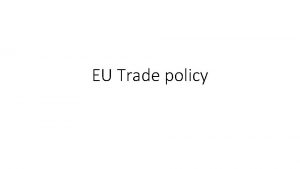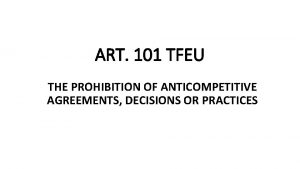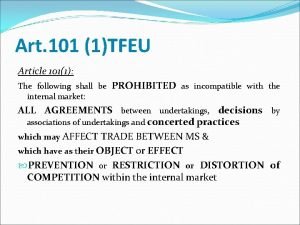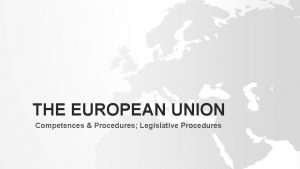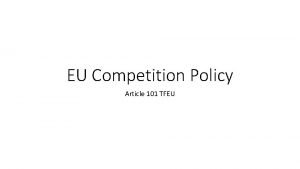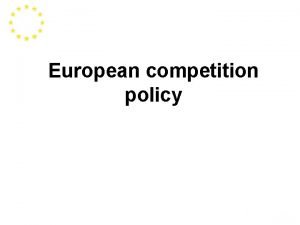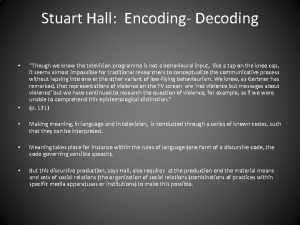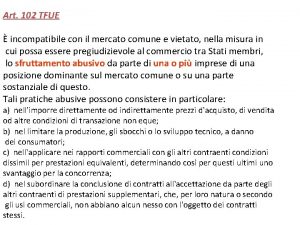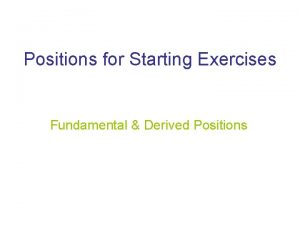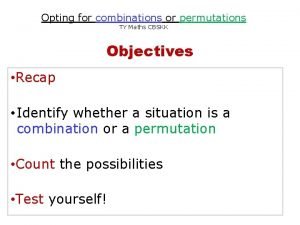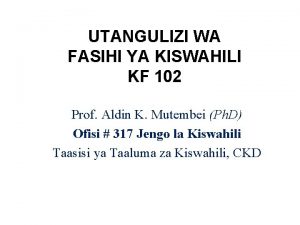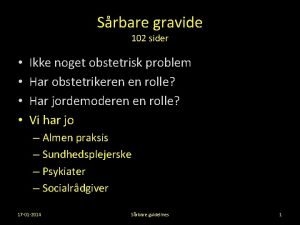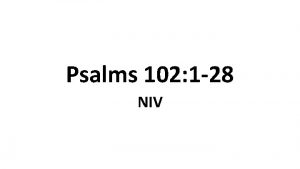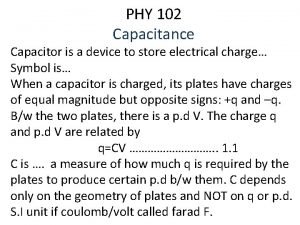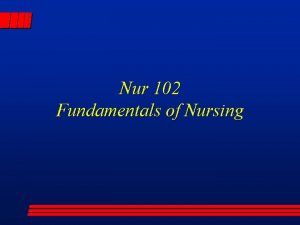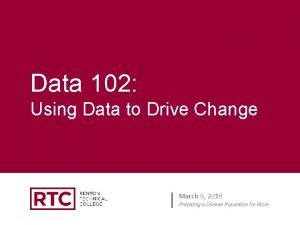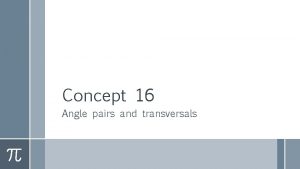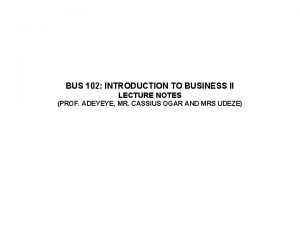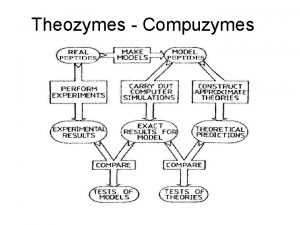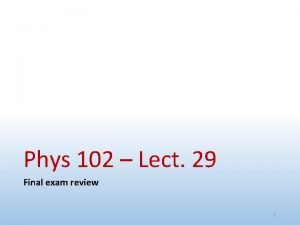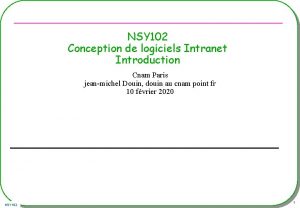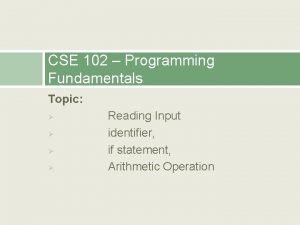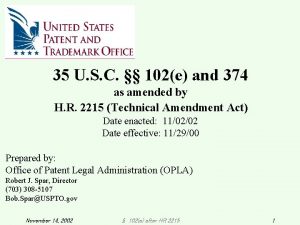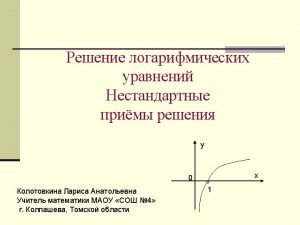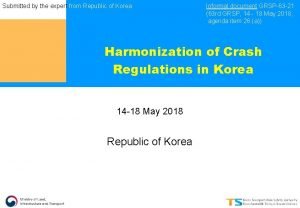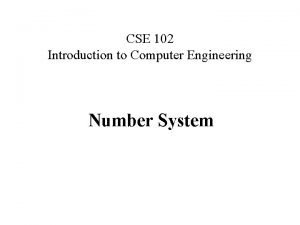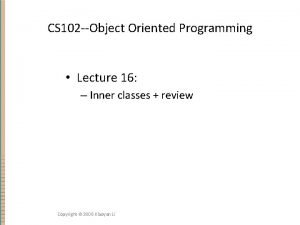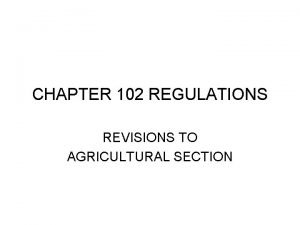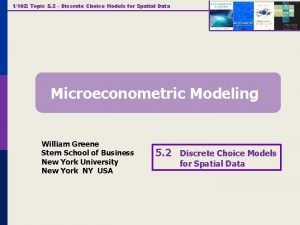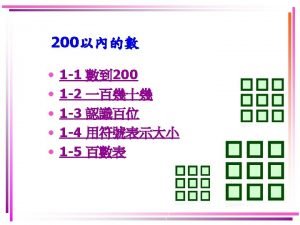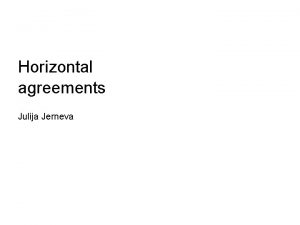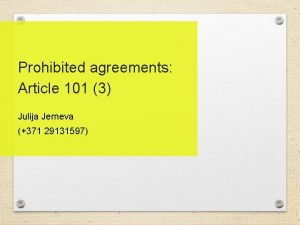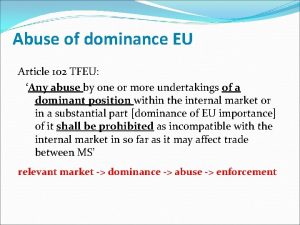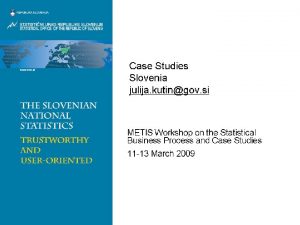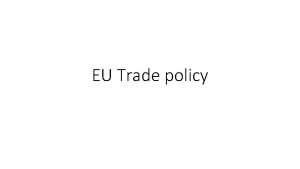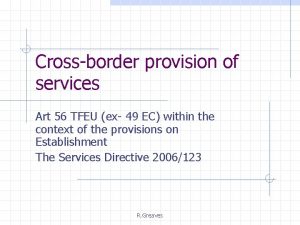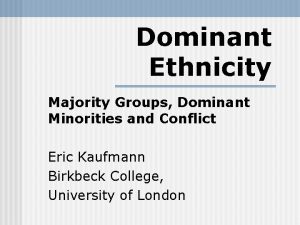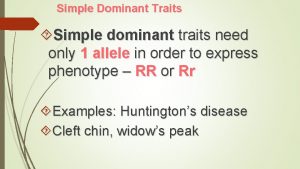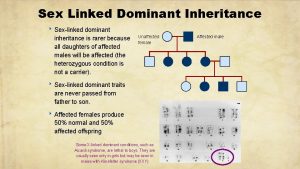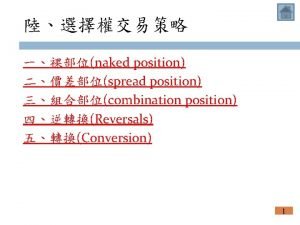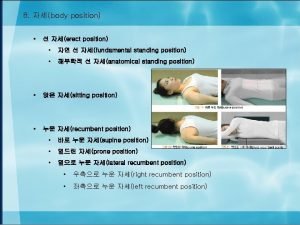Dominant position Julija Jerneva Art 102 TFEU Any















![Pricing – The “core” of Competition Law Ronald Coase [1991 Nobel Prize in economics] Pricing – The “core” of Competition Law Ronald Coase [1991 Nobel Prize in economics]](https://slidetodoc.com/presentation_image_h2/6e630504590dd1144825785d42650002/image-16.jpg)







![Excessive pricing – Legal Standard • Definition: “[c]harging a price which is excessive because Excessive pricing – Legal Standard • Definition: “[c]harging a price which is excessive because](https://slidetodoc.com/presentation_image_h2/6e630504590dd1144825785d42650002/image-24.jpg)






















































- Slides: 78

Dominant position Julija Jerneva

Art. 102 TFEU "Any abuse by one or more undertakings of a dominant position within the common market or in a substantial part of it shall be prohibited as incompatible with the common market in so far as it may affect trade between Member States. Such abuse may, in particular, consist in: (a) directly or indirectly imposing unfair purchase or selling prices or other unfair trading conditions; (b) limiting production, markets or technical development to the prejudice of consumers; (c) applying dissimilar conditions to equivalent transactions with other trading parties, thereby placing them at a competitive disadvantage; (d) making the conclusion of contracts subject to acceptance by the other parties of supplementary obligations which, by their nature or according to commercial usage, have no connection with the subject of such contracts. " 2

Definition of dominance • Dominance not defined in Treaty, but in case law. • Dominance must be in reference to a relevant market (product + geographical). • Market share is the most important indicator but not determinative. • Therefore market definition is essential. 3

Market shares Unlikely dominant 0% 30% Dominant 50– 70% 100% 4

Dominant position • dominance is a position of economic strength enjoyed by an undertaking which: • enables it to prevent effective competition being maintained on the relevant market • during sufficiently long period of time • by affording it the power to behave to an appreciable extent independently of: • its competitors, • its customers and • ultimately of the consumers

• Dominance means substantial market power over a period of time. • If can profitably maintain prices above the competitive level for a significant period of time, then generally dominant. • Indicators: market shares (firm & rivals), entry and expansion by rivals, countervailing buyer power. 6

Collective dominance • Two or more undertakings must from an economic point of view present themselves or act together on a particular market as a collective entity • Undertakings in oligopolistic markets? • Collusive behaviour?

Case 85/76 Hoffmann-La Roche • ”An objective concept relating to the behaviour of an undertaking in a dominant position which is such as to influence the structure of a market where, as a result of the very presence of the undertaking in question, the degree of competition is weakened and which, through recourse to methods different from those which condition normal competition in products or services on basis of the transaction of commercial operators, has the effect of hindering the maintenance of the degree of competition still existing in the market or the growth of that competition. ”

Pricing and non-pricing abuses • Pricing related: predatory pricing, margin squeeze, discount schemes • Non pricing conduct includes: refusal to supply, exclusive dealing, tying and bundling 6

Exclusionary and exploitative abuses • Exclusionary abuses: those, which aim to exclude existing or potential competitors • Exploitative abuses: dominant undertaking exploits dominant position to its own benefit

• only conduct which would exclude a hypothetical “as efficient” competitor is abusive

Horizontal foreclosure • a dominant company attempting to exclude, discipline or marginalise a rival at its own level in the supply chain by foreclosing its access to customers

Horizontal foreclosure A B A 2 C

Vertical foreclosure • the aim is to exclude B, a rival of A in the upstream market, or • the aim is to exclude an already active or a potential participant in the downstream market, for instance Z

Pricing abuses
![Pricing The core of Competition Law Ronald Coase 1991 Nobel Prize in economics Pricing – The “core” of Competition Law Ronald Coase [1991 Nobel Prize in economics]](https://slidetodoc.com/presentation_image_h2/6e630504590dd1144825785d42650002/image-16.jpg)
Pricing – The “core” of Competition Law Ronald Coase [1991 Nobel Prize in economics] said he was tired of competition law because “when the prices went up the judges said it was monopoly, when the prices went down they said it was predatory pricing, and when they stayed the same they said it was tacit collusion” Source: William Landes in "The Fire of Truth: A Remembrance of Law and Econ at Chicago", JLE (1981) p. 193.

A Two-Tier Approach to Pricing • First tier – ex ante sector specific regulation: wholesale and retail prices may be subject to regulatory oversight • Second tier – ex post EC competition law: prices are occasionally subject to regulatory intervention. Besides anti-cartel provisions (Article 101 EC), dominant firms’ pricing policies are subject to the prohibition of abuse of a dominant position contained in Article 102 EC

Business practice Harmful economic effect Legal qualification High prices Customers exploitation Excessive pricing Art. 102(a) Low prices Competitors exclusion Predatory pricing and abusive rebates Art. 102(b) High prices (wholesale) + low prices (retail) Downstream competitors exclusion Abusive margin squeeze Art. 102 (b) Differentiated prices Customers exclusion Price discrimination Art 102(c)

Price = (? ) “costs” (+ “profits”) • sunk costs • fixed costs • variable costs • total costs • marginal/incrimental costs • avoidable costs • average costs • Diversified production: stand alone costs and common costs

• can a competitor, which is as efficient as the dominant company, can compete against the price schedule or rebate system of the dominant company? • whether the dominant company itself would be able to survive the exclusionary conduct in the event that it would be the target?

• reliable information on the pricing conduct and costs of the dominant company?

Excessive pricing

Excessive (or “unfair”) pricing • Originality of EC competition law. Other competition law regimes have chosen to “trust” the market: high prices are short lived as they trigger entry of new firms. In the long run, high prices lead to increased competition in the market place • Enforcement limited to exceptional circumstances: 1. Typically in exorbitant situations where price exceed at least from 100% the costs of the dominant firm. A price simply in excess of the competitive level will not trigger intervention 2. Cases often involving a market partitioning problem (see the United Brands, General Motors, British Leyland cases)
![Excessive pricing Legal Standard Definition charging a price which is excessive because Excessive pricing – Legal Standard • Definition: “[c]harging a price which is excessive because](https://slidetodoc.com/presentation_image_h2/6e630504590dd1144825785d42650002/image-24.jpg)
Excessive pricing – Legal Standard • Definition: “[c]harging a price which is excessive because it has no reasonable relation to the economic value of the product supplied” (United Brands); • Test: “determine whether the difference between the costs actually incurred and the price actually charged is excessive; and if the answer […] is in the affirmative, whether a price has been imposed which is either unfair in itself or when compared to competing products”; • Commission’s practice: four methods have been used (i) price-cost margin analysis; (ii) price comparisons accross markets or competitors; (iii) geographic price comparisons; (iv) comparisons over time.

The Deutsche Post II case • Allegation that DP has abused its dominant position by charging an excessive price for the delivery of incoming international mail. DP Post classifies IIM as circumvented domestic mail and charges the full domestic tariff (0, 56 €). • Commission confronted with an “information” problem üNo cost benchmark available in a monopolistic market: “In a market which is open to competition the normal test to be applied would be to compare the price of the dominant operator with the prices charged by competitors. Due to the existence of DPAG's wide-ranging monopoly, such a price comparison is not possible in the present case”; üNo reliable information on costs: DP had not set a “transparent, internal cost accounting system and no reliable data exist for the period of time relevant to this case”. • By charging the full domestic tariff (0, 56€) for delivery of international mail, DP has exceeded by +/– 25% the economic value of the service (0, 45€); • Importantly, the Commission indicates that an excess of only 25% may be deemed abusive by virtue of the facts that (i) DP is a monopolist and; (ii) of the special features of the postal sector (e. g. liberalization policy initiatives).

Single branding and Discount schemes

Negative effects • Foreclosure of the market to competing suppliers and potential suppliers • If the buyers are retailers selling to final consumers the foreclosure may also lead to a loss of in-store inter-brand competition • Price discrimination between the different buyers (competitors in the downstream market)

Single branding • obligations which require the buyer on a particular market to concentrate its purchases to a large extent with one supplier • ‘English clause’, requiring the buyer to report any better offer and allowing it only to accept such an offer when the supplier does not match it

Unconditional rebates • Unconditional rebates, while granted to certain customers and not to others, are granted for every purchase of these particular customers, independently of their purchasing behaviour • exploitative abuse only

• Unconditional rebates are only problematic where used as a predation means: • the dominant firm selectively eliminates key sources of demand for actual and potential competitors to prevent market entry.

Conditional rebates • Conditional rebates are granted to customers to reward a certain (purchasing) behaviour of these customers • Conditional Rebates are generally problematic.

Incremental and all-unit • incremental rebates (only bear on purchases above threshold) • have a lesser anticompetitive effect • “all-unit” rebates (bearing on all purchases achieved during the reference period)

“all-unit” rebates • produce a “suction effect”, as reaching the target awards a discount on all units purchased up to that point and not only on purchases above the target. • Such rebates have the effect of pre-empting a share of the market that may be critical for rivals’ and new entrants’ abilities to compete with the dominant firm. • In discouraging customers from placing orders with rival producers, all unit rebates are said to be “fidelitybuilding” (legality depends on assessment of the market share covered by the rebates, size of the rebates, level of the threshold, duration of the reference period, etc. )

The De Post/Hays Case • The Belgian postal operator De Post La Poste offered a “preferential tariff” for the general letter mail service subject to the acceptance of a supplementary contract covering a new business-to-business ("B 2 B") mail service • Hays, a competitor active on the B 2 B document exchange network market, could not compete with the tariff reduction offered by La Poste in the monopoly area and was losing most of its clients in Belgium • By tying the tariff reduction in the monopoly area to the subscription of its B 2 B service, La Poste made it impossible for Hays to compete on a level playing field because it could not offer a similar advantage • Form of bundled rebates/financial tying typically prohibited under Article 102(d).

Efficiency enhancing effects • the supplier, in order to supply a particular customer, makes a relationship specific investment

Intel: rebates case • Case COMP/37. 990 • Financial consequences: • Fine: € 1. 06 billion (largest fine on single firm, but only(? ) 4. 15% of the turnover) • Settlement with AMD: $ 1. 25 billion to be paid • Facts: • Dominant position by Intel between October 2002 -December 2007 • Relevant market: x 86 Central Processing Units (CPU) worldwide market (at least 70% market share)

Intel: types of abuses 1. Wholly or partially hidden rebates to computer manufacturers on condition that they bought all, or almost all, their x 86 CPUs from Intel 2. Direct payments to Europe’s largest PC retailer (MSH) on condition that it stocked only computers with x 86 CPUs 3. Direct payments to computer manufacturers to stop or delay the launch of specific products containing a competitor’s x 86 CPUs and to limit the sales channels available to these products

Predatory pricing

Predatory pricing • the practice where a dominant company lowers its price and • thereby deliberately incurs losses or foregoes profits • in the short run • so as to enable it to eliminate or discipline or more rivals or to prevent entry by one or more potential rivals thereby hindering the maintenance or the degree of competition still existing in the market or the growth of that competition

Predatory pricing – Legal Standard üif the dominant firm prices are set below Average Variable Costs (AVC), unlawful predation is presumed. Pricing below AVC has no economic rationale other than the elimination of competitors, since every unit sold is a net financial loss

Pricing below average avoidable cost • Whether the dominant company: • by charging a lower price for all or a particular part of its output • over the relevant time period, • incurred or incurs losses • that could have been avoided by not producing that (particular part of its) output • If such avoidable losses are incurred, the pricing can be presumed to be predatory

Pricing above average avoidable cost but below average total cost • Many reasons: i. e. , serious fall in demand • No presumption

Pricing above average avoidable cost but below average total cost • If the dominant firm’s prices are set above AVC but below Average Total Costs (ATC), unlawful predation can only be established on the basis of additional evidence. • Firms may, in certain circumstances, rationally price above AVC and below ATC, as it still allows the recovery of a share of their fixed costs. • As predation is not the sole economic rationale for such a pricing policy, competition authorities are required to produce additional elements of proof: prices below ATC “will be regarded abusive if they are determined as part of a plan for eliminating a competitor”

Long run average incremental costs • In specific sectors • LRAIC is used as a benchmark • it is presumed that pricing below LAIC is predatory

A different cost standard for network industries • Some economists consider that using the Long Run Incremental Costs (“LRAIC”) benchmark would be better suited: üIn sectors with high fixed costs and low variable costs a price may well equate with AVC – and thus not be prima facie predatory – and still be substantially lower than the price the firm needs to cover the cost of supplying its products and thus be de facto predatory. To address the problem, the Commission has suggested the use of a LRAIC benchmark. The LRAIC covers all the costs incremental to the production of the product at hand, including fixed and variable costs. üIn sectors where dominant firms sell more than one product/service. A difficult issue is how to allocate fixed and variable costs that are incurred in common with two or more products. A solution often supported by economists is to ignore the common costs, and focus only on the costs that are incremental to the production of the specific service at hand.

Above cost pricing • Price cuts above ATC are in principle not predatory, as they can only lead to the exclusion of less efficient competitors only or deter inefficient entrants • Yet, the case-law and the Commission’s decisional practice recognize that in “exceptional circumstances” dominant firms may breach Article 82 EC for selectively undercutting the prices charged to certain customers by competitors, with a view to excluding or deterring the entry of such competitors • The Discussion Paper indicates that “exceptional circumstances” will arise where the dominant firm has certain non-replicable advantages or where economies of scale are very important and entrants necessarily will have to operate for an initial period at a significant cost disadvantage. Because entry can practically only take place below the minimum efficient scale. This factor could be relevant for network industries and the postal sector • Commission has stressed that an abuse will only be found in situations where the price cuts have lead or will lead to “substantial” consumer harm

Price discrimination

Discrimination Wine material producer (A) Sparkling wine producer B (A group company) Sales price Sparkling wine producer C Producer B Producer C 200 400

Price Discrimination – Legal Standard • First condition: applying dissimilar prices to “equivalent transactions” üOften uneasy to determine whether transactions are equivalent. Most obvious reason for stating that two transactions are not equivalent is that the sales involve different costs for the seller. The problem is of course to determine how significant cost differences should be for two transactions to be considered non-equivalent üEuropean commission generally assume that transactions are equivalent without much analysis

Price Discrimination – Legal Standard • Secondition: the dominant firm’s trading parties must be placed at a competitive disadvantage against others üNeed to identify a downstream relevant market; üNeed to show a distorsion of competition on that market üEuropean Commission generally ignores these conditions

Margin squeeze

Margin squeeze • No discrimination!

Test • Four conditions: (i) input supplier is vertically integrated; (ii) input is essential; (iii) the price charged would prevent an efficient competitor from making a normal profit; (iv) there is no objective justification for this pricing strategy;

Wine material producer (A) Sparkling wine producer B (A group company) Sparkling wine producer C Producer B Producer C Purchase price (PP) 40 40 Min. production costs (Min. PC) 40 40 Max competitive retail price (Max. RP) 100 Profit (P = Max. RP – PP) 20 20

Wine material producer (A) Sparkling wine producer B (A group company) Sparkling wine producer C Producer B Producer C Purchase price (PP) 60 60 Min. production costs (Min. PC) 40 40 Max competitive retail price (Max. RP) 100 0 0 Profit (P = Max. RP – PP)

Wine material producer (A) Sparkling wine producer B (A group company) Sparkling wine producer C Producer B Producer C Purchase price (PP) 90 90 Min. production costs (Min. PC) 40 40 Max competitive retail price (Max. RP) 100 Profit (P = Max. RP – PP) -30

• Incentives to engage into margin squeeze is not clearcut. Trade -off for a dominant input supplier: Limitation of downstream competition vs. loss of upstream revenues

Non-pricing abuses • exclusive dealing (single branding) • refusal to supply • tying and bundling 6

Bundling and tying

Tying • A (tying product) not sold without B, but B (tied product) is also sold separately • the supplier makes the sale of one product (the tying product) conditional upon the purchase of another distinct product (the tied product) from the supplier or someone designated by the latter. • Only the tied product can be bought separately

Bundling • A package of two or more goods is offered • Pure bundling: Bundle A-B: neither A nor B is sold separately • Mixed bundling: A-B: both sold individually, but together for a discount. • The bundled goods may be available for individual purchase, but the bundle is sold at a discount to the sum of the prices of the components

Bundling and tying • pure bundling: , • tying: , • mixed bundling: 7

Different forms of tying • contractual tying: tie agreed or dominant party refuses to sell separately • technological tying: tying product cannot function without tied product: touches on separate products question. If not, no tying or bundling • commercial tying: mixed bundling if bundle discount forces customer to buy bundle 8

Discounts with T&B effects • But: effectiveness (common costs? )

T&B extremely common business practices (undisputed) • applied by small and large firms (see Discussion Paper and Microsoft). • many (if not most) not dominant in any market. • Valid reasons to bundle: efficiencies, price-discriminate differentiate product portfolio. 9

Leveraging of market power • T&B by dominant firms can be anticompetitive: • transferring market power in market A into a adjacent market B, or • maintaining or strengthening the existing market power in market A. 10

Test • the company concerned is dominant in the tying market • the tying and tied goods are two distinct products • the tying practice is likely to have a market distorting foreclosure effect • the tying practice is not justified objectively or by efficiencies 17

Lattelecom “Mājas komplekts 1” • Internet + Fixed telephony services = free local calls and cheap calls abroad

Microsoft: PC operating systems case • Case COMP/39. 530 • Automatic tying of 'Internet Explorer' web browser to the 'Windows' computer operating system • deprives consumers of choice • results in fewer innovative products on the market • January 2009: the Commission’s preliminary view that the company abused its dominant position in the market for client PC operating systems through the tying of Internet Explorer to Windows

Microsoft: PC operating systems case • As of March 2010: browser “Choice screen” • "Choice Screen" enables users (from EEA) of Windows XP, Windows Vista and Windows 7 to choose in an informed and unbiased manner which web browser(s) they want to install in addition to, or instead of, Microsoft's web browser • Same applies to users, who receive an automatic update • Available for 5 years • 16 December 2009: Commission’s commitment decision

Microsoft: PC operating systems case • Mr. Nitot, president of Mozilla Europe (27. 10. 2009): “In 17 countries of Europe, Firefox is now the dominant browser, and the browser is particularly popular in Eastern Europe” • Firefox was launched in 2004, i. e. when Microsoft was allegedly foreclosing the market

Refusal to supply

• Undertakings (also dominant) are generally entitled to determine whom to supply and to decide not to continue to supply certain trading partners

Refusal to supply: horizontal foreclosure • Aimed at excluding the competitor of the dominant company • halting supplies to punish buyers for dealing with competitors • refusing to supply buyers that do not agree to exclusive dealing or tying arrangements

Refusal to supply: vertical foreclosure • a dominant company denies a buyer access to an input in order to exclude that buyer from participating in an economic activity • the termination of an existing commercial relationship • the refusal to supply products, to provide information, to license intellectual property rights (IPR) • the refusal to grant access to an essential facility or a network. • Free riders?

RWE Group: German gas supply case • Case COMP/39. 402 • RWE may have abused the dominant position on its gas transmission network to restrict its competitors' access to the network • Types of abuses: • Capacity management: systematically keeping the transport capacity on its gas network for itself • Margin squeeze: setting transmission tariffs at an artificially high level with the effect of preventing even a competitor as efficient as RWE from competing effectively on the downstream gas supply markets or limiting competitors' or potential entrants' ability to remain in or enter the market

RWE: commitments • RWE committed to divest its entire Western German high-pressure gas transmission network, including the necessary personnel and ancillary assets and services • Competition Commissioner Neelie Kroes commented: "This very substantial set of remedies will fundamentally change the landscape of German gas markets…RWE will no longer be able to use the control of its network to favour its own gas supply affiliate over its competitors. "

Thank you! Jūlija Jerņeva Mob: +371 29131597 https: //www. linkedin. com/in/julijajerneva
 Art 207 tfeu
Art 207 tfeu Art. 101 tfeu
Art. 101 tfeu Art. 101 tfeu
Art. 101 tfeu Eu ordinary legislative procedure
Eu ordinary legislative procedure Second position
Second position Romeo i julija kviz
Romeo i julija kviz Crte po toku i karakteru
Crte po toku i karakteru Romeo i julija tema
Romeo i julija tema Apostrofa
Apostrofa Ugf izmaksas jūlijā 2021
Ugf izmaksas jūlijā 2021 Osnovna škola julija kempfa požega
Osnovna škola julija kempfa požega Aleksej karenin
Aleksej karenin 63 tfeu
63 tfeu Article 101 tfeu
Article 101 tfeu 101(3) tfeu
101(3) tfeu Stuart hall encoding
Stuart hall encoding 102 tfue
102 tfue Cf art 102
Cf art 102 There isnt any cheese
There isnt any cheese Any to any connectivity
Any to any connectivity Seknder
Seknder Starting and derived positions
Starting and derived positions A basketball team has 12 members who can play any position
A basketball team has 12 members who can play any position Fundamental position vs anatomical position
Fundamental position vs anatomical position What is fundamental position
What is fundamental position Physics 102 electricity and magnetism
Physics 102 electricity and magnetism Uiuc physics 102
Uiuc physics 102 Fasihi ya kiswahili pdf
Fasihi ya kiswahili pdf Servicelovens 102
Servicelovens 102 Convenio 102 de 1952 oit
Convenio 102 de 1952 oit Psalms 102 niv
Psalms 102 niv Psalm 102:25
Psalm 102:25 Physics 102
Physics 102 102 capacitor
102 capacitor Nur 102
Nur 102 Met 102
Met 102 Renton technical college renton wa
Renton technical college renton wa Csc 102
Csc 102 Alternate exter angles
Alternate exter angles Convenio 102
Convenio 102 Introduction to business notes
Introduction to business notes 657 102. madde
657 102. madde Tc 7-102
Tc 7-102 Asp 102
Asp 102 I 102 104
I 102 104 Physics 102 final exam
Physics 102 final exam Alternate exteior angles
Alternate exteior angles Jmx 102
Jmx 102 Bisp 195
Bisp 195 Minecraft redstone counter
Minecraft redstone counter Cse102
Cse102 Phép trừ bù
Phép trừ bù Sinak s-102
Sinak s-102 35 usc 102
35 usc 102 Lgx=5
Lgx=5 Iat 102 sfu
Iat 102 sfu Spacing in graphic design
Spacing in graphic design 102 graphic
102 graphic Kmvss article 95
Kmvss article 95 Iho s-102
Iho s-102 George carlin age
George carlin age Area 102
Area 102 Kmvss 102
Kmvss 102 Lisa weaver
Lisa weaver Psychology 102 practice test
Psychology 102 practice test Egee 102 home activity 4
Egee 102 home activity 4 +10210
+10210 Cs 102 midterm
Cs 102 midterm Fitness chapter 102
Fitness chapter 102 Fitness 102
Fitness 102 Bisc 102 sfu
Bisc 102 sfu 704 marking system
704 marking system 102 graphic
102 graphic Ni 23-102
Ni 23-102 100 101 102 103 104 105 106 107 108 109 110
100 101 102 103 104 105 106 107 108 109 110 Iat 102
Iat 102 Bs 102
Bs 102 Ess 102
Ess 102 Ess 102
Ess 102
